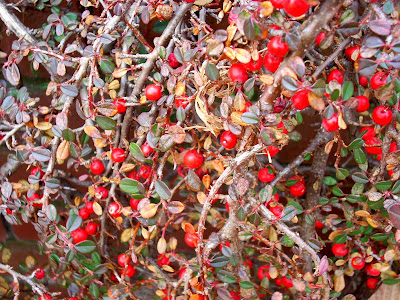
The Mid-Atlantic region got teased last week with temperatures in the mid-70's. It was great fun while it lasted but the reality is we are still in winter; we shouldn't legitimately have warm weather like that until late March-April. And that's just fine by me-- it gives me a chance to find more neglected beauty in winter gardens.

While many gardens lie dormant in the winter, I still find beauty in them. You can find colorful berries, seasonal branches, gorgeous evergreens, hardy perennial plants and sometimes early blooming spring flowers, if you're lucky. Last weekend I found all of these things, as well as quite a few surprises when I went to Washington, D.C. for the day.

I decided to check out a few of my favorite gardens around the mall, including the Enid Haupt and Mary Livingston Ripley gardens, and Katherine Dulin Folger rose garden. Each are located near or behind the seemingly out-of-place Smithsonian Information Building, a dwelling that looks more like a castle than a place for tourists seeking direction. Since it was cold, there were few people wandering through, which was fortunate for me--I was left in privacy to do my research.

The first garden I visited was the Mary Livingston Ripley Garden, located between the Arts and Industries building and Smithsonian Castle. It was very well-maintained; the grasses and perennials were all properly cut-back and the ground had clean mulch and wood chips, evidence the landscaper may have made a visit. While most of the plants were dormant, I spotted some life, including these dainty snow bells popping up under a maple tree. They are like Spring's early spokesmen, quietly announcing better things are yet to come.

I looked across the path and found some pretty red berries in this lively cotoneaster plant. Its branches flowed over the brick ledge onto the ground which I found beautiful.

Further down was this Corylus Avellana, a.k.a. Harry Lauder's Walking Stick. Without leaves, the spindly branches stood out and made a wavy effect next to the vertical Euphorbia Characas, or mediterranean spurge.

The full and bushy spurge boasted a bright green color next to the leafless plants surrounding it. There was some more green to be seen in the center island garden--beds of lush rosemary that had managed to escape an earlier frost.

When I turned the corner, there were branches of bright yellow that demanded my attention. I thought they belonged to forsythia bushes, but on closer inspection, I found two witch hazel trees, (Hamamelis x Intermedia) in full bloom. The smell was so clean and fresh, it was just what I needed as I put on my mittens. The temperature started to drop which served as a reminder that I was fortunate to be seeing life and color in this perennial plot so early on.

Beside the witch hazels were three very fertile Oregon Grape Holly (Mahonia aquilifolium) shrubs. The blooms looked like they could sprout anytime-- probably due to last week’s warm weather.

On my way out, I passed this unseasonal, tropical-looking yucca plant (Yucca recurvifolia). While D.C. is 60 miles south of Baltimore, the temperatures are often the same, so seeing tropicals thriving in February is very unexpected. A woman had entered the garden as I was leaving, and she kept saying aloud how beautiful everything was. It was so nice to hear someone compliment the winter garden when so many others walked by were mumbling how much prettier it will be in May. The lady told me she was from Pennsylvania, which may explain her appreciation . Their winters can be much more brutal than ours.

Next, I headed over to the Haupt gardens where there was still some winterberries decorating planters and gates. All of the winterberries seemed to be in tact; I have never seen birds eating them, not even in my own garden.

As I started down the sidewalk, on my right stood another healthy tropical plant-- a Yucca rostrata that looked like something out of Dr. Seuss. It was perfectly shaped. Right next to it was an unidentified succulent, maybe an American agave, but I'm not sure. Many plants were tagged, but not all.

All around the perimeter of the garden were saucer magnolias. You could see the buds starting to fatten on the ends of the branches. Also called Japanese tulip magnolias, saucer magnolias are among my favorites; I loved the look of their swollen blooms against the rest of the barren limbs.

The last plant that caught my attention was this strange looking shrub I fell in love with. It drove me wild when I walked past... its blooms seemed so untimely and exotic, I had no idea what it was. I crawled in between some boxwoods and found a tag that said 'Maroon tree peony'. I'm not sure if that's its true name, but would love to find out. Up close, the blooms looked like paper-cut mushroom-flowers.

That's about it for my second winter beauty run. Although I scouted quite a few bright winter pansies, I found these vibrant flowers, trees and shrubs (shown) more worthy of showcasing in their usually dormant landscape. I plan on one more winter run, hopefully, with some snow if Mother Nature is feeling abundant. White winter beauty-- that has a nice ring.

4 comments:
Unusual flowers... very impressive finds during a very unimpressive time of year. Nice work.
Did you see the Wollemi Pine? It is an ancient species just found in Austrailia. Only a few hundred survive. They have one in that garden.
The one you were wondering about is not a tree peony (there must be one nearby), it is an Edgeworthia aka Paper Bush. It's pretty rare, and way cool.
:-)
I just discovered your bog by the way, and I love it!
:-)
Discovered your blog and am recommending it through mine-www.aroundcrownsville.com. Great for our Crownsville nature lovers.
Post a Comment